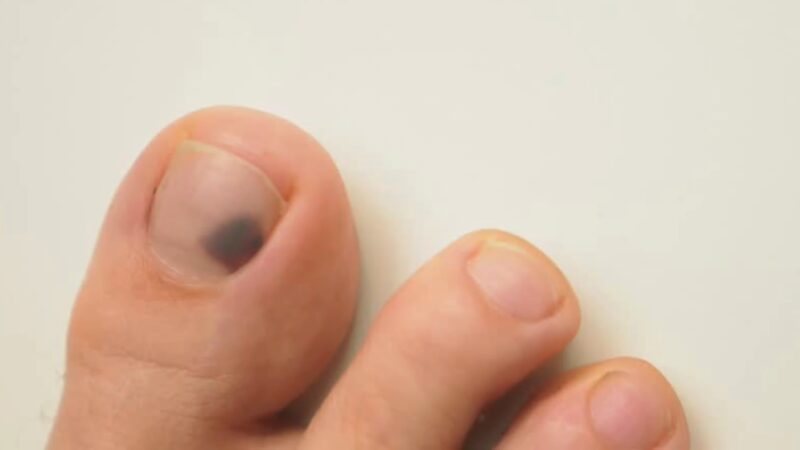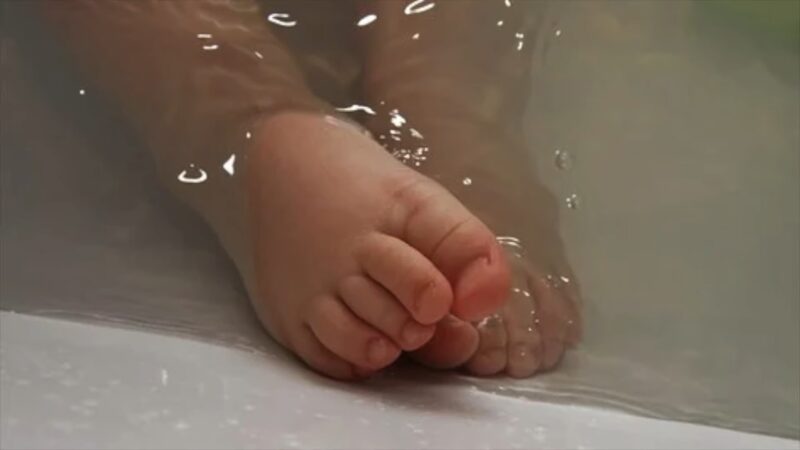Sustaining a broken toenail can be both uncomfortable and unsightly, leading many to wonder if it’s possible to still indulge in the pampering experience of a pedicure. Safety concerns, the potential for further injury, and the effectiveness of the treatment frequently arise in this scenario.
Professional salons are equipped to handle such situations, working carefully around the damaged toenail to provide a pedicure that not only beautifies the feet but also adheres to proper hygiene and care standards.
Safety and aesthetics are not mutually exclusive when it comes to a less-than-perfect toenail. Individuals must understand how to navigate the precautions and care necessary when seeking a pedicure with a broken toenail.
Knowledge about appropriate salon practices, combined with self-care tips, can ensure that the toenail heals properly while maintaining the overall appearance of the feet.
Table of Contents
ToggleKey Takeaways
- A broken toenail does not preclude the possibility of getting a safe pedicure.
- Proper salon procedures can accommodate a damaged toenail, ensuring safe and hygienic care.
- Understanding self-care and salon care for a broken toenail enhances healing and maintains foot aesthetics.
Pedicures and Toenail Cosmetics
When dealing with a toenail injury, the approach to pedicures and the use of toenail cosmetics should be handled with special care to promote healing and prevent exacerbating the injury. Here are some detailed considerations:
| Category | Recommendations |
|---|---|
| Communication with Technician | – Inform the technician about the injury before the pedicure. – Discuss limitations or precautions for the session. – Ensure the technician can adapt techniques to accommodate the injury. |
| Gentle Care | – Opt for gentle polish applications. – Avoid harsh chemicals like strong nail polish removers. – Avoid artificial nails or heavy nail art until full healing. |
| Hygiene | – Ensure salon hygiene and tool sterilization. – Consider bringing your own pedicure tools. – If at home, sterilize tools and work in a clean area. |
| Product Selection | – Use nail products free from harmful chemicals. – Consider breathable or sensitive nail polishes. |
| Monitoring for Changes | – Monitor the injured toenail for signs of worsening, like pain or redness. – Seek medical advice if adverse changes are noticed. |
Things You Need to Know about Broken Toenail
Broken toenails can result from various injuries or conditions and may affect the toenail’s base, tip, or nail bed. It’s essential to identify the symptoms correctly, understand the causes and risk factors, and know when to seek medical attention to prevent complications.
Identifying a Broken Toenail
A broken nail on the toe is typically evident through various signs of damage, which can manifest in different parts of the nail, including the base, tip, or along the nail bed.
To accurately identify a broken nail, it’s important to be aware of several key symptoms:
Discoloration
Changes in the color of the nail can be a primary indicator of damage. This might include darkening of the nail or the appearance of white spots or streaks.
Discoloration can result from a range of causes, such as trauma to the nail, fungal infections, or even underlying health issues.
Splitting
A clear sign of a broken nail is when it splits. This can occur either horizontally, known as onychoschizia, or vertically, referred to as onychorrhexis.
Horizontal splits are often caused by external trauma or injury, while vertical splitting can be a result of long-term stress on the nail or nutritional deficiencies.
Separation
Another common symptom is when the nail begins to detach from the nail bed, a condition medically known as onycholysis.
This separation can be partial or complete and is often accompanied by pain and discomfort. It can be caused by injury, infection, or even prolonged exposure to water or chemicals.
Additional Signs
In some cases, a broken nail may be accompanied by other symptoms like pain, especially if there’s significant trauma involved.
Swelling or redness around the nail, and in severe cases, bleeding or the formation of a hematoma (blood clot) under the nail, can also occur.
Common Causes and Risk Factors
Several factors can lead to a broken nail on the toe, with the most common causes being:
| Cause Category | Description |
|---|---|
| Trauma | – Primary cause of a broken nail on the toe. – Can occur from dropping heavy objects on the foot or stubbing the toe. – Sports injuries or accidents during physical activities can lead to traumatic nail injuries. |
| Repetitive Pressure | – Caused by constant pressure from wearing tight, narrow, or ill-fitting shoes. – Common in athletes or individuals who frequently wear high heels. – Activities like long-distance running that stress the toes can contribute to this issue. |
| Aging | – Nails become drier and more brittle with age, increasing susceptibility to breaking. – Nail growth rate slows down with age, contributing to higher risk of nail damage. |
Additional Causes and Risk Factors
- Fungal Infections:
Fungal infections can weaken the nail structure, making them more prone to breaking or splitting.
These infections can also cause the nail to become thick and distorted, which increases the risk of trauma.
- Nutritional Deficiencies:
Lack of essential nutrients like biotin, iron, and protein can lead to weaker nails and increase the likelihood of breakage.
A diet deficient in vitamins and minerals can adversely affect nail health.
- Chemical Exposure:
Frequent exposure to harsh chemicals, such as those found in cleaning agents or nail care products, can weaken the nails.
Prolonged use of nail polish removers, especially those containing acetone, can also contribute to nail brittleness.
- Medical Conditions:
Certain medical conditions, such as psoriasis or thyroid disorders, can affect the health and strength of the nails.
Peripheral vascular disease, which affects blood flow to the limbs, can also impact nail health.
When to Seek Medical Attention
It’s important to know when a broken nail on the toe requires a doctor’s attention. Seek medical care if you notice:
- Severe Pain: Indicating significant damage or underlying issues.
- Redness and Swelling: Signs of inflammation or infection.
- Signs of Infection: Such as pus or an unpleasant odor.
- Fever: This could indicate a more serious infection requiring immediate attention.
Prompt medical intervention is crucial to prevent complications and ensure proper healing.
Complications of Broken Toenails
While a broken toenail might seem minor, it can lead to several complications if not properly managed:
- Infection: The skin around the nail can become infected, characterized by redness, swelling, and pain.
- Fungal Infections: Damaged nails are more susceptible to fungal growth, leading to further nail deterioration.
- Ingrown Toenail: Incorrect healing or trimming can cause the nail to grow into the skin, causing discomfort and infection.
- Subungual Hematoma: This occurs when blood accumulates under the nail, often requiring medical intervention to relieve pressure and pain.
Prevention Strategies
To minimize the risk of toenail injuries, consider the following strategies:
- Footwear Choices: Opt for shoes that fit well and provide enough room for your toes. Tight shoes can increase pressure on the nails.
- Sock Selection: Wear socks that fit properly and don’t constrict toe movement.
- Nail Care: Regularly trim your nails straight across to prevent them from becoming too long and vulnerable to breakage.
- Protective Measures: In environments where foot injuries are more likely, such as during certain sports or heavy lifting, wear protective footwear.
Healing and Recovery Process
The recovery timeline for a broken toenail varies depending on the severity of the injury:
- Minor Injuries: These typically heal on their own. The nail will gradually regrow over several weeks to months.
- Severe Cases: More significant damage may require medical treatment, such as nail removal or surgery, to ensure proper healing and prevent complications.
Home Treatment Options
Managing a broken nail on the toe at home involves several steps to promote healing and prevent infection:
- Soaking: Soak the affected foot in warm, soapy water. This can help clean the area and reduce the risk of infection. Do this for about 15-20 minutes.
- Keeping it Dry and Clean: After soaking, ensure the toe is thoroughly dried. Keep the toe clean to prevent bacterial growth.
- Antibiotic Ointment: Apply a thin layer of antibiotic ointment to the damaged nail area to fight infection.
- Pain Management: For discomfort, over-the-counter pain relievers like NSAIDs (Non-Steroidal Anti-Inflammatory Drugs) can be effective. Follow the dosage instructions on the label.
Professional Treatment Approaches
In cases where home treatment isn’t sufficient, professional medical intervention may be necessary:
- Podiatrist Consultation: A podiatrist can offer specialized treatments, which might include the removal of the damaged nail or, in severe cases, surgical intervention.
- Diagnostic Procedures: The initial appointment may involve a review of treatment options and possibly an x-ray to assess the extent of the damage.
- Follow-Up Care: Regular follow-up appointments may be required to monitor the healing process and adjust treatments as necessary.
Navigating Day-To-Day Activities
Adapting daily routines is crucial for a smooth recovery:
- Footwear: Choose shoes that provide ample space and comfort for the injured toe. Avoid tight or constrictive footwear.
- Activity Modification: Limit activities that exert pressure on the injured toe. This might mean avoiding certain sports or standing for long periods.
- Routine Adjustments: Be mindful of your daily activities and make necessary adjustments to avoid further trauma to the nail.
Health Conditions Related to Toenail Trauma
Certain health conditions can impact the likelihood and healing of toenail trauma:
- Diabetes: Can slow down the healing process and increase the risk of infection.
- Psoriasis: This skin condition can affect nail health and complicate recovery.
- Poor Circulation: Impaired blood flow can delay healing and increase the risk of complications.
Cosmetic Solutions and Considerations
While cosmetic solutions can be tempting, they should be approached carefully:
- Artificial Nails: Using an artificial nail or nail glue can temporarily cover the damage but consult a professional to avoid worsening the condition.
- Salon Advice: Seek advice from a salon professional or podiatrist before applying any cosmetic products to the damaged nail.
- Infection Risk: Be aware that cosmetic solutions can potentially increase the risk of infection or further breakage.
Follow-Up Care and Monitoring
Regular follow-up with a podiatrist allows monitoring of the healing process and treatment effectiveness to ensure proper treatment of broken toenails and prevention of infection.
FAQs
https://www.youtube.com/watch?v=4P-vMILCtBE&embed=true
Navigating the do’s and don’ts of pedicure with damaged toenails is essential for safe foot care and aesthetics. This section will answer common questions related to pedicures and broken toenails.
Is it safe to have a pedicure with a broken toenail?
Yes, it is generally safe to have a pedicure with a broken toenail, provided that the injury is not fresh or painful. Professionals know how to handle these situations and can avoid causing further damage to the nail.
What treatments are available for a missing toenail during a pedicure session?
For a missing toenail during a pedicure, a salon technician can trim any excess nail and file down rough edges. They can also apply a protective covering to keep the area clean.
Are there any special precautions to take for a pedicure when dealing with nail fungus?
When dealing with nail fungus, it’s crucial to inform the salon so they can take necessary sanitation precautions and avoid the spread of infection. A sterile environment and tools are crucial.
Can a salon perform a pedicure on a horizontally or vertically cracked toenail?
Salons can perform pedicures on a cracked toenail, but the approach varies depending on the severity of the crack. Minor cracks can be gently filed, while severe cases may require more specialized care.
How does one handle a pedicure when the big toenail is completely absent?
When the big toenail is completely absent, the focus shifts to caring for the skin and any remaining nail tissue. The area can still be soaked, cleansed, and moisturized, ensuring the toe is well-cared for.
What type of pedicure can someone with damaged toenails receive?
Individuals with damaged toenails can receive a gentle pedicure tailored to their needs. This can include avoiding polish on the damaged nails, focusing on moisturizing the feet and cuticles, and a careful cleaning to avoid aggravation.
The Bottom Line
Getting a pedicure with a broken toenail is generally possible, but it requires careful consideration and potentially modified procedures. It’s crucial to assess the severity of the break and ensure that there is no risk of infection or further injury.
Consulting with a healthcare professional before heading to the salon is advisable, especially for significant breaks or if there are signs of infection. A professional pedicurist can often work around a minor break, ensuring that the rest of the foot is pampered and cared for while avoiding further damage to the injured area.




















